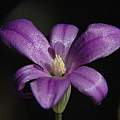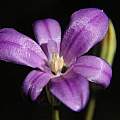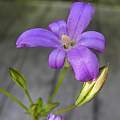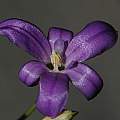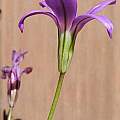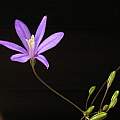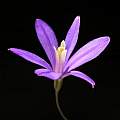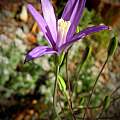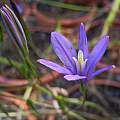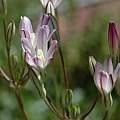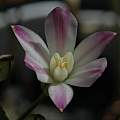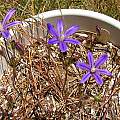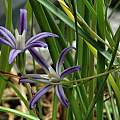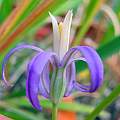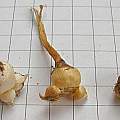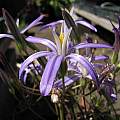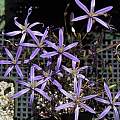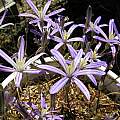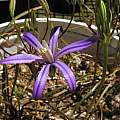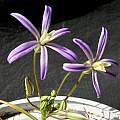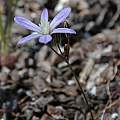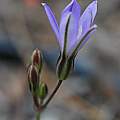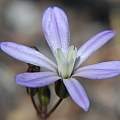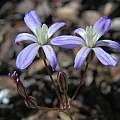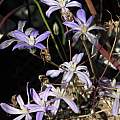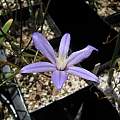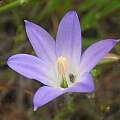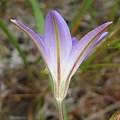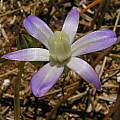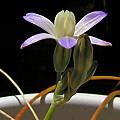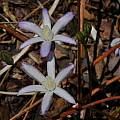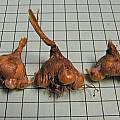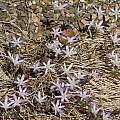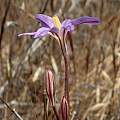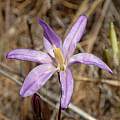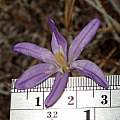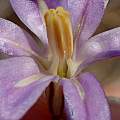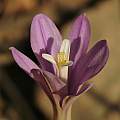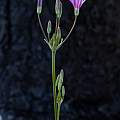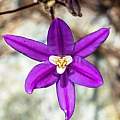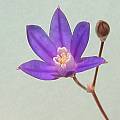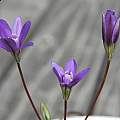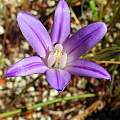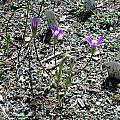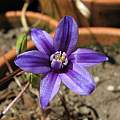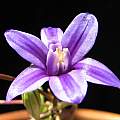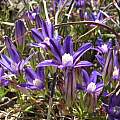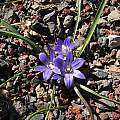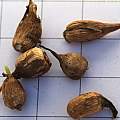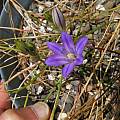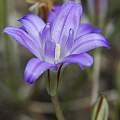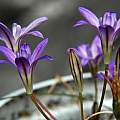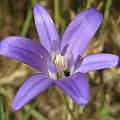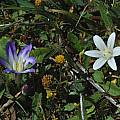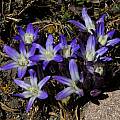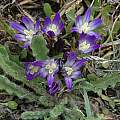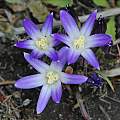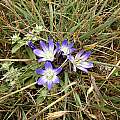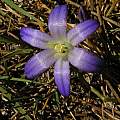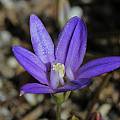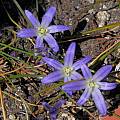Brodiaea is a genus restricted to western North America, ranging geographically from Vancouver, B.C. to Baja California. This genus is in the Liliaceae, Asparagaceae or Themidaceae family depending on which taxonomists you follow. More information can be found on the main Brodiaea wiki page.
Brodiaea species k-z are found on this wiki page.
Brodiaea kinkiensis Niehaus is commonly known as San Clemente Island brodiaea or larkspur and is endemic to San Clemente Island, one of the Channel Islands off the coast of Southern California. Click for map The native Gabrielino-Tongva people are said to have called the island Kinki or Kinkipar. This species is found in clay soil in grassland. It is extremely rare. The flowers are purple or violet with a narrow bell-shaped tube and spreading lobes. The inner tepals are round and the staminodes erect with a pointed tip and held away from the stamens. The stamens are unusual with the free part of the filaments triangular-winged and the anthers widely notched between the pollen chambers. Flowering May-June, this species is very short, growing to 1 in (2.5 cm). Photos from Mary Sue Ittner who grew this species from seed. Blooming in May 2014, it was a long time from seed to flower. In cultivation it is much taller and not all the flowers had staminodes with a pointed tip as shown in the photos.
Brodiaea leptandra (Greene) Baker, syn. Brodiaea californica Lindl. ssp. leptandra (Greene) J.C. Pires, syn. Brodiaea californica var. leptandra (Greene), known as the narrow-flowered brodiaea, is restricted to lava and serpentine slopes where it grows in open mixed-evergreen forest or chaparral at 40-1220 m in Napa, Lake, and Sonoma counties, flowering May to July. Although this species is recognized by Plants of the World Online and the Jepson eflora, in 2024 Flora of North America continues to include it in Brodiaea californica as a subspecies. Growing from 20 to 70 cm, it is generally smaller (shorter and with smaller flowers) than Brodiaea californica and the margins of the white to lavender staminodes generally flat, 1/4 inrolled, with the midrib noticeably thickened. Photos from Bob Rutemoeller and Mary Sue Ittner of plants previously identified as Brodiaea californica ssp. leptandra.
Brodiaea matsonii R.E. Preston is an extremely rare species restricted to a single extended population along Sulphur Creek in Redding, Shasta County, California that is related to Brodiaea minor but has slightly smaller pale pink flowers. Published in 2011 after being identified, it grows from cracks and crevices in bedrock along an intermittent stream within foothill woodland. It usually flowers in early June on short stalks from 6 to 8 inches (10-25 cm) tall in a cluster of six to eight flowers. Photos from Dean Taylor shared here under a CC BY-SA 3.0 license.
Brodiaea minor (Benth.) S.Watson was studied by Robert Preston in a paper entitled A Reconsideration of Brodiaea minor (Benth.) S. Watson and Brodiaea purdyi Eastwood (Themidaceae) in 2006. He examined existing herbarium material and did a morphological examination of field collected material and determined that some of the previous names were not correct. In that paper he writes: "The results of this paper demonstrate that Niehaus’s (1971) concept of B. purdyi, the polyploid small-flowered species, with spreading perianth lobes and floral tubes that are narrowed above the ovary, and that occurs in woodland habitats in the northern Sierra Nevada foothills, applies to the taxon originally described as B. minor and as recognized by Jepson (1922) and Hoover (1939), placing B. purdyi in synonymy with B. minor." In this same paper plants considered to be Brodiaea minor at that time were now determined to belong to the resurrected species Brodiaea nana Hoover. The Jepson eflora and Plants of the World Online both accept these changes, but in 2024 the Flora of North America does not appear to be updating its classification and still includes Brodiaea purdyi Eastw. and there are references online that continue to refer to Brodiaea minor as it was previously understood. These two species are very similar, but Brodiaea minor is taller (10-25 cm) and has staminode tips spreading to erect with margins 3/4 inrolled and stamens narrow-notched between anther sacs.
Commonly known as Purdy's brodiaea or small brodiaea, this species is found in the Sierra Nevada foothills of Northern California in open woodlands and often on serpentine. It has blue-violet flowers distinguished by narrow spreading tepals and an urn-like tube. The white staminodes are narrow, erect, held close to the stamens but above the petals, with inrolled margins and notched tips. It blooms from April to June. Photos 1-4 were taken by Mary Sue Ittner, including a picture of the corms on a 1 cm grid. Photos 5-6 were taken by Nhu Nguyen showing the staminodes and a full-blooming specimen.
A cultivar of this species was once sold by the Robinetts under the name Brodiaea purdyi 'Blue Ribbons'. Photos by Bob Rutemoeller and Mary Sue Ittner show a container with many flowers open at the same time as well as close-ups.
Brodiaea nana Hoover, syn. Brodiaea minor var. nana (Hoover) Hoover, was reinstated by Robert Preston in 2006 when he examined existing herbarium material and did a morphological examination of field collected material of what was then named Brodiaea purdyi and Brodiaea minor and determined that some of the previous names were not correct. See Brodiaea minor. Plants that were considered Brodiaea purdyi became Brodiaea minor and plants that were then considered to be Brodiaea minor were moved to a reinstated species, Brodiaea nana. He concluded: "The results of the morphological analysis show that Brodiaea nana should be recognized as a taxon distinct from Brodiaea minor, and on both morphological and cytological grounds."
Brodiaea nana ranges from Merced County, California north to Butte County with populations on volcanic mudflows in Tehama and Shasta Counties. It occurs in vernal pools and swales in the hot foothills of the Sacramento Valley at an elevation of 10-410 m. Known as the Dwarf or Vernal Pool Brodiaea, flowers are violet, spreading with narrow petals and the tube pinched in just below the petals. Height: about 2-10 cm. The staminodes are erect, white, held close to the stamens, margins 1/2 inrolled with a notched tip. It flowers April to May. Photo 1 was taken by Bob Rutemoeller and photos 2-4 were taken by Mary Sue Ittner of the first bloom from seed of this very small species in June 2009. Mary Sue found this species very difficult to keep going in her garden (both grown from seed and purchased bulbs.) On the other hand, the taller version (Brodiaea purdyi) has been successfully grown for years.
The photos below were taken by Nhu Nguyen.
Brodiaea orcuttii (Greene) Baker is a very rare species commonly known as Orcutt's brodiaea found in clay soil on serpentine substrate under vernally-flooded conditions in meadow and vernal-pool and stream habitats in Riverside and San Diego counties to Baja California. The red-purple to blue flowers with widely spreading lobes are similar to Brodiaea filifolia but have no staminodes. Although Jepson lists this species as growing to 10" (25 cm) tall, I have seen much taller plants, to 18" (and also much shorter plants, 5"). Orcutt's brodiaea blooms April-July, as the vernal area begins to dry up. Photos by Jim Duggan.
Brodiaea pallida Hoover is commonly known as Chinese Camp brodiaea. This species is a rare California endemic, considered rare and endangered and found in serpentine substrate under vernally-flooded conditions in riparian habitats near Chinese Camp, Tuolumne County. It has pale purple or lilac flowers, sometimes with a white center and the tube is urn-shaped. The staminodes are erect, white, and held close to the stamens with inrolled margins and deeply notched tips. Height: about 20 cm. Pictures are of garden grown plants originally purchased from plants grown from seed. Photos 1-2 were taken by Bob Rutemoeller and photos 3-4 were taken by Mary Sue Ittner. Photo 4 shows the corms on a 1 cm grid. Photo 5 was taken by Nhu Nguyen of a lovely patch at the UC Botanical Garden.
Brodiaea purdyi Eastw. see Brodiaea minor.
Brodiaea santarosae T.J.Chester, W.P.Armstr. & Madore, named in 2007, is found on basalt soils in southwest Riverside County and part of San Diego County, California at an elevation of 580-1045 m. It is a rare and endangered species. In the past it was considered to be an intergrade of Brodiaea filifolia and Brodiaea orcuttii, but has been elevated to species status. Growing from 9 to 36 cm, it has violet flowers with white to lavender narrow or small staminodes tapered to the tip. Flowers are larger than Brodiaea filifolia flowers. Flowering is May to June. Photos taken by Ron Vanderhoff and shared under a shared under a license.
Brodiaea sierrae R.E.Preston is a diploid species from the Sierra Nevada foothills of California (Butte, Yuba, and Napa counties) where it grows in chaparral, cismontane woodland, and lower montane coniferous forest often on serpentine soils between 50 and 980 m (most species between 320 and 945 m.) Growing from 20 to 80 cm, it has violet ascending flowers with recurved tips and flowers May to August. It was previous included in Brodiaea californica and is similar to Brodiaea leptandra, a species formerly (and still by some authorities) considered a subspecies or variety of Brodiaea californica. It has larger flowers than those other two species with lobes up to 53 mm long and different staminodes from Brodiaea california. It has staminodes that are uniformly wide and recurved only at the tip with entire margins 1/4 inrolled. Brodiaea californica has staminodes that are recurved from the middle and narrow at the apex with undulate-dentate margins. Photos from Calflora taken by David Greenberger and Steve Laymon in Butte County and shared under a CC BY-NC license.
Brodiaea stellaris S.Watson or the star-flowered brodiaea is a low-grower and is found on serpentine slopes in the middle Coast Ranges from Sonoma County to Humboldt County. It has blue-purple flowers with wide, blunt, white staminodes and small appendages behind the anthers and blooms May-July. Height range: 15-30 cm. The first three photos were taken by Bob Rutemoeller and Mary Sue Ittner. The fourth was taken by Mark McDonough. It shows this species growing in his Massachusetts garden, where it was surviving and flowering late June each of the next 4 years after he purchased a couple of bulbs from Jim Robinett in 1999. Photos 5-6 were taken by Nhu Nguyen of a form from Telos Rare Bulbs.
Brodiaea terrestris Kellogg is a coastal bluff and coastal prairie plant with stems appearing to be half buried beneath the soil. Commonly known as dwarf brodiaea or earth brodiaea, this species grows from California to Oregon. The flowers are light blue to blue-violet with a triangular tube. The angled staminodes are white to violet, leaning inward but held away from the stamens. It blooms from April into June depending on the location. There are two subspecies. The first two photos were taken by Nhu Nguyen. Photo 2 was taken at the Tilden Botanic Garden of a plant labeled as Brodiaea minor that is probably this species. Corms received in PBS BX 321 #7 grown by Nhu Nguyen and labeled NNBH1205 are shown on a 1 cm grid in photo 3 by M. Gastil-Buhl.
Brodiaea terrestris ssp. kernensis (Hoover) Niehaus is a subspecies that can be taller (2 to 20 cm) with larger flowers, violet (sometimes white) staminodes and a green ovary. The anther tips are erect to reflexed, generally without a dentate lobe in the notch. The plant in the first photo from Bob Rutemoeller was grown from wild collected seed in Kern County California at a high elevation. The next two photos from Mary Sue Ittner. The last photo was taken by Jim Duggan from a San Diego County population.
Brodiaea terrestris ssp. terrestris is the shortest subspecies (.5 to 7 cm). It has white to pale violet staminodes and anthers with reflexed tips and a dentate lobe in the notch. These pictures show it in habitat in Northern California. The first four were taken at Salt Point State Park. One shows a rare white flower. Photos by Mary Sue Ittner and Bob Rutemoeller.
Brodiaea index - Brodiaea species a-j
